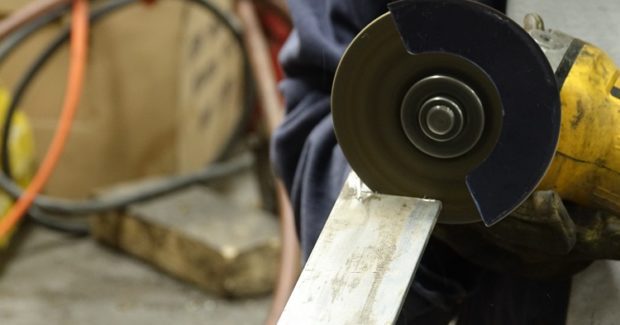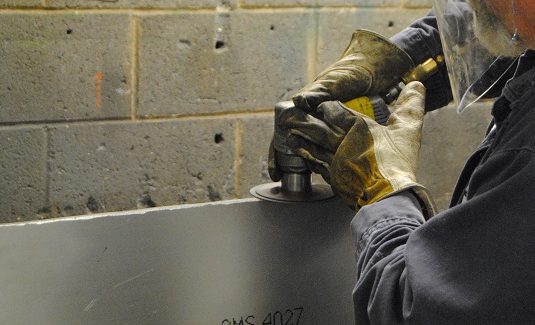Tips and Tools for Cutting, Grinding and Finishing Aluminum
Pressure and heat are the main culprits of frustration when working with aluminum. To improve the quality, safety and productivity of your work while reducing downtime and labor costs, here are some insights on how to choose the right wheel or disc to address the needs of the pre-weld and post-weld operation.
Posted: September 6, 2017
While aluminum has been used in shipbuilding for decades, a growing number of other applications now use aluminum in metal fabrication due to its high strength-to-weight ratio and superior corrosion resistance. Since 2005, the demand for the material has grown at a faster rate than any other metal or alloy primarily because of its increased popularity in additional market segments, such as structural framing, trailer manufacturing and repair, service decks and ladders, and platform construction. Perhaps most notably, Ford switched to aluminum as the body material their most popular truck, the F150.
For all of the benefits that aluminum offers fabricators, it can also bring challenges: it can be one of the more difficult materials to cut, grind and finish efficiently because it has a lower melting point than other metals. The heat and friction that build up during these processes quickly melts the aluminum, causing it to stick and accumulate on the abrasive to the point that it’s taller than the cutting grain. This loading or clogging of material eventually prevents the abrasive from cutting and causes the wheel to stop working altogether. In addition to loading, other common challenges when working with aluminum include contamination and the potential for porosity and oxide inclusions, and achieving the desired finish:
- Porosity can occur when contaminates from abrasive products release from the wheel and contaminate weld surfaces. This compromises the structural integrity of the weld. It is critical to remove surface contaminates prior to welding, including grease, oil, dirt, or paint, and only use high quality, contaminate-free abrasives for surface preparation and inter-pass grinding.
- Oxide inclusions occur when the aluminum oxide layer is not removed properly. Prior to welding, it is necessary to remove the thin, transparent film of aluminum oxide from the surface to ensure the overall weld strength and fatigue resistance. A stainless steel brush dedicated for the job works well.
- Finish is a challenge when working aluminum because the material can be easily damaged with overly aggressive practices.
Many welding professionals today approach aluminum cutting, grinding and finishing by relying on one or more of the following tools or methods. Each of these, however, also have disadvantages in terms of cost, quality, productivity and safety:
- Jig saws, reciprocating saws, shears. The downside is that they create a lot of noise and vibration, and form large burrs.
- Lubricants and silicon spray (WD-40, LPS). The downside is that they can be flammable and contaminate the work surface, requiring careful clean-up prior to welding.
- Wax and grease. The downside is that they can be dangerous, especially when applied while discs are running. They also require careful clean up prior to welding.
- Excessive pressure. A common reaction when a wheel is not performing as desired is to push harder. But pushing harder exasperates the problem by creating even more heat and friction, melting the aluminum even more rapidly as the wheel loads faster and faster. The downside is that this generates additional heat, can damage the work piece and can even cause the wheel to fail.
A BETTER CHOICE FOR CUTTING, GRINDING AND FINISHING ALUMINUM
The goal when choosing a product for cutting, grinding and finishing aluminum is to have the right wheel or disc to address the needs of the pre-weld and post-weld operation. The right choice can help shops gain better quality, safety and productivity. It can also minimize downtime and labor costs. A type 27 grinding wheel that doesn’t load is an option when cutting and/or grinding aluminum. These wheels feature grain blends selected for consistent performance and a contaminant-free bond. High quality, aluminum-specific products are designed to cut smoothly while minimizing burr formation. They also significantly reduce the noise and vibration through the cut, and are therefore easier to control. Wheels are available for cutting or grinding only, or as combination cutting/grinding wheels.
Resin fiber discs (RFDs) designated for aluminum are a good option for grinding, blending and finishing. RFDs are used with a firm rubber backing pad that offers flat, consistent contact with the material during use, making them easier to control and blend. The best discs are pre-treated or coated with a lubricant to reduce heat buildup while grinding. This feature helps delay melting of the aluminum, preventing the disc from loading and offering higher cut rates, along with a longer product life. Another alternative to a resin fiber disc for grinding, blending and finishing are treated or top-coated flap discs. These discs are available in a variety of grain options; however, they are not as popular in the industry since they are more pliable and require a higher skill set to gain the desired surface finish. That said, they offer the advantage of time savings in some cases, since they allow for grinding and finishing in one step; there is no need to switch from a Type 27 grinding wheel to a resin fiber disc to complete the job.
Since aluminum is easy to damage, some welding operators use non-woven hand pads or 0000 steel wool to finish by hand and minimize potential damage to the part. Non-woven discs and wheels, though, can save time compared to manual finishing. Non-woven discs and wheels are ideal for decorative finishing, satin and antique finishes, final sanding, soft metal finishing and fine burr removal. Power brushes for cleaning also help get the job done quickly without applying excessive pressure that could damage the aluminum.
FINAL THOUGHTS
Pressure and heat are the main culprits of frustration when working with aluminum. It is important to use high quality, contaminate-free products and to let the wheel do the work. Applying pressure to increase performance will only lead to additional frustration and compromise quality. Also, a strong, consistent weld begins with proper surface preparation. The cleaner the seam being welded, the better the weld penetration. For best results always use a product that is designed for use on aluminum. The best products will cut cleanly and smoothly without pitting, gouging or undercutting. There are several high performance products available to get the job done quickly and efficiently, so always consult your trusted distributor abrasive manufacturer to understand what options are available for the application. For more information and to view an aluminum solutions guide, please click here.
Subscribe to learn the latest in manufacturing.






